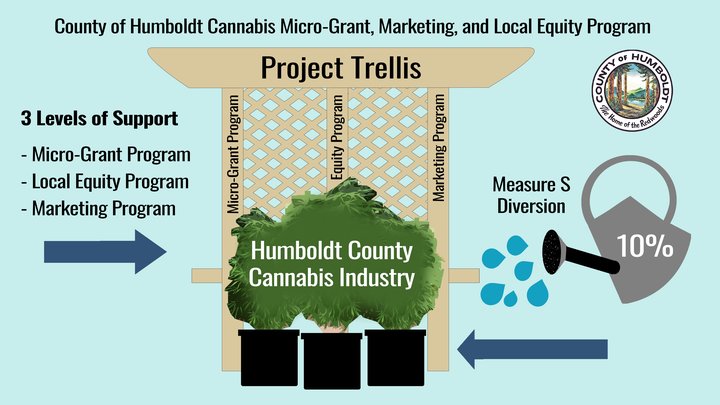
‘Project Trellis’ graphic created by the county’s economic development staff.
At its regular meeting tomorrow morning, the Humboldt County Board of Supervisors will hear a presentation on what staff are calling “Project Trellis” — a new county mechanism for assisting the local cannabis industry with direct microgrants, a regional cannabis marketing campaign and the establishment of a “local equity program,” through which certain local industry participants might receive larger state grants.
“Project Trellis” would be funded, at least in part, by a portion of Measure S funds. Measure S is the county’s excise tax on cannabis cultivation, which voters approved in 2016. Measure S took in some $17 million
According to a staff report to the board, a program like this is necessary because unlike most other industries the marijuana business is not eligible for the usual palette of federal assistance to small business and private industry. The staff writes:
There are a wide range of federally funded support and service programs that exist for a diversity of industries. However, the cannabis industry is not among them. Due to its federal illegality, some grants and support services that are offered to other businesses (for example, through the Department of Agriculture Grants, Small Business Development Commission support, bank loans for infrastructure and capital acquisition, etc.) are not available to cannabis businesses. When federal dollars are not available for particular industries and/or specific populations it is incumbent on communities to develop and administer their own programs.
What would “Project Trellis” do, exactly? The way staff has designed it, it would be a sort of three-pronged project.
1. It would designate some local body — either the Headwaters Fund Board or a new advisory committee — to distribute small grants to applicants from the cannabis industry who need funding to undertake small projects. This would be funded by two percent of whatever the county takes in from Measure S, along with money raised through enforcement against non-compliant growers.
2. It would institute some sort of countywide cannabis industry “marketing and branding” campaign, probably in conjunction with consultants. Seven percent of total Measure S revenues would be spent on this effort.
3. It would set up a local “cannabis equity program,” which would interface with the state’s cannabis industry social equity program — a big pot of funds designed to assist disadvantaged people who want to break into the industry. The state’s program is sitting on a $10 million pot of cash, staff writes, and we need a local program for local people to tap those funds. One percent of Measure S revenues would be diverted to this effort, along with more dollars from enforcement actions, but the idea is that it could eventually be supported in part from a percentage of the state grants it facilitates.
County staff are pitching this triple approach as the best way local government can help local industry thrive in the market going forward:
Why a Trellis? Communities thrive when they create services and infrastructure which are aimed at supporting the critical components of their own economies. Metaphors for support structures are commonplace. And, just as a garden trellis is designed to support and encourage plant growth (upward growth in particular), the adoption and implementation of Project Trellis can serve to support and sustain the local cannabis industry until a point of industry stabilization, or beyond.
Also on the agenda tomorrow: The board will hear an update on the status of the Potter Valley Project, the dams down south that divert water from the Eel River watershed into the Russian. Earlier this year, PG&E officially announced that it wants to abandon the dams. What comes next?
The Board of Supervisors meets tomorrow at 9 a.m. in it chambers at the Humboldt County Courthouse (825 Fifth Street, Eureka).
###
DOCUMENTS:
CLICK TO MANAGE